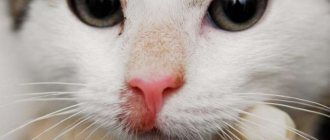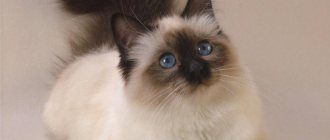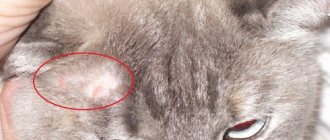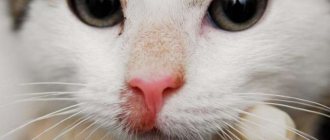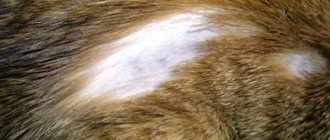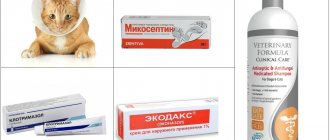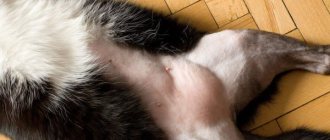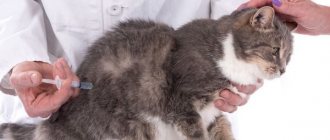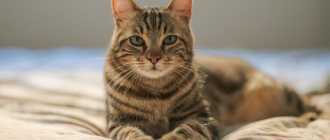Since ancient times, cats have brought benefits to humans by their appearance in the house. They can catch small rodents or comfort and cheer up their owner with their affection. But it happens that mustachioed pets need human help in treating diseases. One of these diseases is lichen in cats . What it is and how to deal with it we will consider further.
Types of cat lichen with photos
Ringworm is a dermatological disease caused by various fungi or viruses. In cats, it appears on the skin, fur or claws, and its species have different variants of appearance.
When fungal spores enter the body of domestic animals, the latent period (incubation) lasts from several days to a month, then the external manifestations of cat lichen begin, which is distinguished primarily by hair loss on the skin. Among the cat species there are the following:
Lichen planus
Appears when the animal’s immune system fails. The reasons for its occurrence are unknown, and it is not transmitted to other individuals. Characterized by itchy red blisters with liquid on the skin or mucous membranes. When scratched, the pimples burst, causing more itching.
Pityriasis rosea
Transmitted virally from one animal to another. This type of lichen occurs in kittens and adults, but goes away on its own when the immune system is strengthened. It looks like a pink spot measuring 1.5 to 2 cm, the surface of which is flaky and itchy.
Ringworm (eczema)
Sometimes accompanied by fungal infections. It looks like inflamed reddish spots with blisters, as well as severe itching. When scratching pimples, the itching becomes even stronger. Not contagious to other animals.
Pityriasis versicolor (variegated)
Occurs from a fungal infection. Popular in countries with hot climates, it spreads quickly and unnoticed. It looks like small yellow-brown spots, without much inflammation.
Ringworm
The most common and dangerous lichen in cats. We will talk about it further.
Kinds
About forty species of dermatophyte fungi are known that can infect animals. In cats, the culprit of dermatophytosis is a fungus - Microsporum canis. It is a microorganism that can infect other species, including dogs, as well as humans.
Microsporia - caused by the fungi Microsporum gypseum, Microsporum canis.
Microsporia (Microsporum gypseum, Microsporum canis.)
Trichophytosis is caused by the fungus Trichophyton.
Trichophytosis (Trichophyton)
Despite the different names of microorganisms, the characteristics of both species are the same.
Because of the symptoms, the disease is called ringworm.
How to recognize ringworm
Ringworm in cats comes from fungi such as Trichophyton, Microsporum gypseum and Microsporum canis. The first type provokes a disease called trichophytosis, and the second and third types – microsporia. The symptoms of these two diseases are very similar. They can only be recognized in laboratory conditions.
Fungi can exist both on an infected animal and in areas where it is located. Reproduction of fungi occurs through spores, the viability of which reaches two years. They reproduce well in warm and moist conditions.
In addition, spores can remain for a long period on furniture, carpet or fallen hairs of a sick cat, and then become a cause of infection for the next animal.
Ringworm around the cat's eye
Ringworm affects areas of your cat's skin, fur, or claws. Most often, lichen begins to spread from the cat’s face, its paws, then moves to the ears, stomach, back, and tail. Its main symptoms:
- Bald spots of round or oval shape.
- Inflamed skin in affected areas.
- Frequently scratching the cat in places where lichen appears.
- The appearance of greasy crusts that feel like dandruff.
- Occasionally there are pimples.
At the first symptoms of ringworm, spots 1 cm in size appear on the cat. If the spread of the disease is not noticed, they will quickly spread throughout the pet’s entire body. The fungus itself has the ability to exist on an animal for years, but it cannot be cured in one fell swoop. So you should pay close attention to the problem at the first manifestations of lichen in a cat.
Symptoms of lichen in cats
The disease ringworm got its name for a reason - animals lose certain areas of their coat, as if they had been cut.
At the initial stage, the pathology manifests itself as a rash on the infected area of the skin. However, under the fur, especially in long-haired breeds, the primary signs may not be noticed.
In this case, careful observation of your pet's behavior will come to the rescue - he may become more anxious. Frequent scratching of certain areas of the skin may indicate that the kitten is infected with lichen.
Video
As the disease progresses, the symptoms of the disease become more pronounced: the animal develops round spots of baldness, and in the central zone of these spots the skin becomes covered with scales and peels off.
Who is susceptible to the disease
According to statistics, cats with compromised immunity are susceptible to the disease, including individuals who are experiencing a period of another illness or are weakened.
Also, rapid infection with lichen fungus occurs in old cats and kittens; animals with long hair also fall into the category of quickly catching the disease.
Ringworm is often found in purebred cats, for example, Persian cats, since they are artificially bred and do not have natural immunity to this disease.
Some cats can only be carriers of lichen. That is, infection with lichen occurs, but the disease does not begin. And when such a pet begins to come into contact with other animals, they may contract the disease.
Diagnosis of ringworm
Usually, the visible signs of ringworm in cats are difficult to identify at first glance. A popular way to determine the disease is to use a fluorescent lamp, also called a Wood's lamp. In a dark room, the lamp turns on and shines on your beloved pet.
If your cat has ringworm, the glow will be acid green. But the effectiveness of this method works with an accuracy of up to 60%. This is due to the fact that not all fungi are visible, and the animal itself may not get sick, but only carry lichen on its fur.
The best way to find out what's going on with your cat is to go to the vet. It is a specialist who will be able to use research to determine the type of disease in a mustachioed pet.
The doctor will collect samples of the fungus from the cat; these may be crusts or scales from the lichen spot. In some cases, a blood test is performed on the animal. In addition, the specialist will detect other diseases in time.
If, at the same time as shingles, the cat is infected with other viruses or parasites, then the risk of deterioration in the cat’s health increases.
Therefore, furry pets need to be treated, especially since feline lichen occurs in humans too. Children and adults with weak immune systems suffer the most from it.
Danger to humans
We found that ringworm from cats is freely transmitted to humans.
Children and the elderly are susceptible to fungal skin diseases. Treatment of a person is a long process. A mild form of dermatophytosis can develop into a chronic form and negatively affect the entire functional activity of the body.
Over time, the infection weakens the immune system and becomes a conduit for many other diseases. A person can become infected through contact with a cat, even during the incubation period. Spores found on hairs can enter the human body when touched. Therefore, it is necessary to treat in the early stages, as quickly as possible, in order to prevent the spread of fungi.
Where does the infection come from?
A cat can become infected with shingles anywhere. First of all, walking down the street and communicating with other pets suffering from lichen. Also, the focus of fungi is objects after infected animals, these can be bedding, bowls, toys or wool on the floor with fungal spores. Spores can exist for up to a year without their victim.
Another source of infection are rodents, which are hunted by a meowing pet. But then the cat’s lichen will not be the only problem. By catching mice or rats, mustachioed pets can pick up other equally unpleasant diseases.
But furry pets who do not leave the apartment are also at risk of becoming infected with lichen. Because bringing fungus into your home happens more often than people realize. Coming home from the street, a person brings in various germs and dirt on the soles of his shoes, while people change their shoes into slippers, but pets come into direct contact with lichen with their paws.
A person gets a lichen infection from an animal through banal stroking of fur. Having a strong immune system, there is a chance to avoid the disease. But due to prolonged contact with a sick cat, infection can still occur.
Where can a cat get infected?
First of all, lichen is transmitted through contact with sick cats. Spores remain for a long time on objects that the pet has come into contact with, which means that it can become infected through a sleeping place, brushes, toys and other things.
At risk, cats that walk outside exchange bacteria with homeless, unvaccinated animals. At first, the disease may not manifest itself in any way, and only after a few months the first signs and symptoms appear.
Kittens under one year of age, those who are poorly fed, those who have suffered other diseases, and animals infected with parasites are most susceptible to deprivation. Their immune system is unable to resist dermatophytes. Most cats do not get ringworm due to their strong immune system.
The risk of contracting an infection increases if the cat is infected with parasites or has an incomplete diet.
Treatment with folk remedies
Treatment of lichen in cats is possible at home. In the early stages, when a bald spot on the animal’s body has just become noticeable, traditional medicine helps out. Before using them, you need to use scissors to trim the hair around the affected area of the cat. The following methods are popular:
- Iodine - the lichen spot is smeared with iodine twice a day using an ear stick. It is also necessary to treat the edges of the lichen spot . You should use iodine carefully, as it can cause skin burns if applied too much.
- Brilliant green solution - used as an adjunct to iodine treatment. Zelenka alternates with it every other time.
- Ash - to obtain it, you should burn a sheet of newspaper, and then mix the collected ashes with any vegetable oil. Rub the resulting mixture onto the affected area two to three times a day.
- Solidol is a technical product for cars, but it treats ringworm in cats much faster than other traditional medicine. It is safe for the animal if the cat suddenly tries to lick the lubricated area. Apply twice a day.
- Tar soap - this soap is used when bathing a cat. You can also use the tar itself by treating your pet’s lichen with it.
When using these products, you should take a responsible approach to the cat’s health by protecting it with a special collar for animals (also called a post-operative collar). If a cat is pregnant, feeding kittens with milk, or the kittens themselves are up to two months old, you cannot remove ringworm from cats yourself; treatment at home can aggravate the situation or harm the animal, even to the point of death. It is imperative to take your pet to a veterinarian for examination and carry out treatment under his supervision.
Treatment of ringworm with medications
In order for your pet to get rid of lichen as quickly as possible, it must be shown to a veterinarian. Treatment of lichen in cats should be carried out after the results of the examination by the doctor and the prescription prescribed by him. But there are times when it is impossible to get to a veterinary clinic, or the cat does not tolerate transportation at all. Then the following treatment options will help get rid of the disease.
Each cat needs individual treatment. In veterinary clinics, the doctor first determines the criteria listed below.
- Degree of disease.
- Areas affected by lichen.
- The degree of immunity of the animal.
Knowing the state of these criteria, the veterinarian makes a prescription on how to treat lichen in a cat . If the degree of infection is low, the disease has just begun, it is enough to inject vaccines for therapeutic and prophylactic purposes.
But in advanced cases, pets need antifungal drugs, preferably for internal and external use. The best method of therapy will be complex treatment - a combination of vaccination, local therapy drugs, the use of tablets and drugs that enhance immunity.
It is important to disinfect the premises at the same time as treating your furry friend, since lichen spores could be spread throughout the house by the animal. All corners and carpets should be vacuumed and surfaces washed with soapy water. It is also necessary to use a quartz lamp. If possible, keep a sick animal in quarantine from other pets at home and exclude their contact with children.
Local preparations
Typically, these drugs are applied to the affected areas of the animal. Since they are not safe for internal use, it is necessary to put a wide collar around the cat’s neck to prevent the pet from licking the medicinal product from the body.
Shampoos
Antifungal shampoos are used to treat lichen in cats. Their action alone will not relieve a meowing pet from the disease; it should only be used in a comprehensive manner. It is also not recommended to mix anti-lichen shampoos with regular shampoos.
Nizoral and Sebozol are considered good ones. They contain Ketoconazole, which is excellent against various fungi, infections and bacteria. It is necessary to wash your pet with shampoo 2 times a week for 1.5-2 months.
Ointments, sprays, creams
There are many liquid preparations that help fight lichen in cats, the treatment of which has long been neglected. Before using any ointments, sprays or creams, the animal's skin must first be prepared by cutting short the hair around the lichen spot.
To cure ringworm in a cat, it is recommended to use ointments that contain Clotrimazole. It perfectly helps get rid of fungi, although its use will last at least a month. More advanced products with his participation are Sanoderm and Fungin. Their action heals wounds, relieves inflammation and itching.
The drug Miconazole has a good bactericidal effect. By rubbing it into your pet's skin, it destroys lichen fungi. Yam BC ointment also helps eliminate various dermatological diseases, including ringworm.
But Imaverol can be used to treat lichen in pregnant cats and kittens.
A good option for getting rid of lichen would be sulfur and salicylic ointments.
The affected areas of the skin are lubricated generously with ointment twice a day. The advantage of these drugs is their low cost.
Tablets against lichen
Drugs recommended for oral administration to mustachioed pets are most often intended for humans. You should definitely consult with your veterinarian before setting the correct dosage for your animal. Otherwise, your pet may suffer from an overdose. The following tablets will help cure lichen in a cat:
- Ketoconazole
- Itraconazole
- Fluconazole
- Griseofulvin
These oral remedies complement complex treatment and also destroy lichen in cats. They contain antifungal drugs. While taking them, it is necessary to monitor your pet’s well-being, as they have some contraindications.
In order for the cat to swallow the desired tablet or capsule, you should take it by the head at the withers with one hand. When the cat opens its mouth, you need to quickly stick the tablet closer to the throat with your other hand and close the animal’s mouth. Keep it closed until the swallowing movement occurs. After this, the furry pet can be released.
Prevention
It is definitely better to follow preventive measures than to treat lichen in a cat. To comply with this, you must limit your mustachioed pet’s access to stray cats. They can be a carrier not only of lichen, but also of other equally serious diseases. Your cat should be examined weekly for fungal disease.
Owners themselves should not forget to wash their hands with soap after contact with other people's animals. And if a person takes pity and decides to bring a stray kitten from the street, it is better to first go to a veterinary clinic so that specialists can examine the animal and, if necessary, prescribe appropriate treatment.
To prevent the appearance of lichen in cats, it is recommended to vaccinate annually. An experienced veterinarian will help carry it out in the clinic. In addition, a vaccinated animal can more easily tolerate the disease itself if it occurs.
Possible complications
If the disease is not treated, lichen can spread to large areas of the body and become chronic, causing severe suffering to the small creature. If it is itching, it can cause a bacterial infection, then you will have to introduce antibacterial agents into the treatment (as prescribed by the veterinarian and taking into account the age and weight of the cat).
